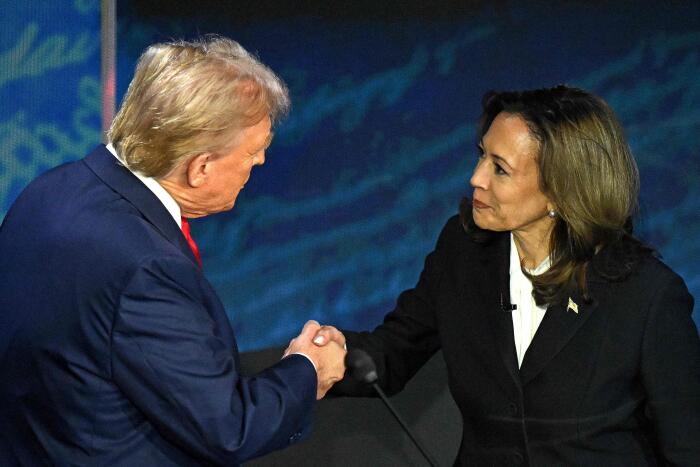Among the most important shifts to watch for will be in the climate policy space, decarbonisation of supply chains, CBAM and rising climate impacts.
The outcome of the 2024 U.S. election battle between Vice President Kamala Harris and former President Donald Trump is expected to shape one of India’s most important economic and strategic relationships. The world’s fifth-largest economy has nurtured its ties with the U.S. across partisan divides. And while bilateral ties have grown in spite of power shifts in both nations, this year’s U.S. election has raised the stakes for bilateral and multilateral equations between the U.S. and the entire world.
Given the closely contested election between Harris and Trump, India – like all major nations of the world – may need to recalibrate some of its strategies, subject to who wins the election in the world’s most powerful economy. Among the most important shifts to watch for will be in the climate policy space, amid the increasing centrality of climate in economic and trade policies in an age of clean energy, decarbonisation of supply chains, CBAM and rising climate impacts.
The U.S. under Trump had announced its intent to exit the Paris Climate Agreement in 2017, creating uncertainty in global climate initiatives. His policies on economic and trade policies rejigged global supply chains. And while a possible Harris presidency is expected to ensure continuity in global ties, her perspective on climate finance and policy remain less clear, especially in the midst of ongoing violent conflicts in Ukraine and Palestine.
Despite the political shifts in the U.S. over the last decade, India has remained committed to its own climate goals and has worked on building a less carbon-intensive economy, while growing its GDP. And strong U.S. opposition to China aligns with India’s Indo-Pacific goals and India continues to be viewed across party lines as a counterbalance to China’s growing influence. Even so, the impact of a change of guard at the helm in the U.S. will likely reshape India’s equation with the U.S. on climate policy and in turn on its economic growth plans. Climate change and technology transfer remain essential elements of U.S.-India cooperation.
Economic Ties
With a bilateral trade valued at around $118 billion, economic ties remain a cornerstone for the India-U.S. relationship. Harris may prioritise continuity of initiatives started under Biden when the U.S.’ Development Finance Corporation placed more emphasis on climate-friendly investments in India, supporting projects like renewable energy infrastructure and green technology development.
Trump has been known for his protectionist stance – he recently criticised trade imbalances calling India a “big abuser” of trade agreements. And in June 2019, the U.S. revoked India’s Generalised System of Preferences (GSP) status, removing duty-free benefits on certain Indian exports and raised concerns over high tariffs on motorcycles and medical devices.
Yet, one of the biggest economic policy initiatives in India’s favour under the Trump administration was the U.S.-India Strategic Energy Partnership (SEP), established in 2018. This partnership expanded energy trade and investment between the two nations, increasing private investments in India’s clean energy plans even though he de-prioritised government backing. Under the last Trump administration, U.S.-based private equity firms, such as Warburg Pincus and Goldman Sachs, invested in Indian renewable energy companies.
Clean Energy Partnership
If elected, Harris is likely to maintain many of Biden’s trade and climate policies, supporting a resilient, cooperative U.S.-India relationship. The U.S.-India Strategic Clean Energy Partnership (SCEP) under Biden included collaborative projects in hydrogen energy, electric mobility, and battery storage, advancing India’s clean energy technology. Through the Initiative on Critical and Emerging Technology (iCET), Biden also promoted technology transfer and joint research in clean tech. She may also back the increased investments by the DFC in India’s renewable projects. Under Biden, the SEP facilitated U.S. private sector investments in India’s clean energy sector to support its goal of achieving 175 GW of renewable capacity by 2022.
Under Trump, U.S.-India clean energy cooperation was more limited but still present, with efforts focused on energy trade, private sector engagement, and foundational partnerships. Launched in 2018, the SEP promoted cooperation in energy security, including renewables, oil, and gas. The SEP facilitated technology transfer and joint research in areas like energy storage and grid modernization, supporting India’s clean energy transition.
Climate Finance
If Harris continues the work started under Biden’s administration, which prioritised climate change in the U.S.-India relations, India can expect more funding for its transition needs. In 2021, Biden launched the U.S.-India Climate and Clean Energy Agenda 2030 Partnership, aiming to mobilise significant climate finance for India’s renewable energy and climate adaptation goals. She may also continue to back DFC’s enhanced mandate under Biden on financing low-carbon projects and helping India transition from coal, in addition to Quad Climate Finance Initiatives under which the Biden administration worked with India, Japan, and Australia to coordinate regional climate finance strategies to increase funding for climate resilience projects in India and the Indo-Pacific.
Under Trump, who has previously criticised climate finance mechanisms, such as the Green Climate Fund, labelling them as wealth redistribution schemes unfavourable to the U.S., there may be a reluctance to allocate funds for international climate efforts, including those in India. Going by the last experience, however, India may see some bilateral and private sector investments into clean projects. For instance, in 2018, the U.S. Overseas Private Investment Corporation (OPIC) committed $350 million to ReNew Power, one of India’s largest renewable energy companies.
About The Author
You may also like
Companies in BASIC nations are turning carbon rules into an advantage: Report
Can green trade barriers save the environment?
Brazil Set 60-Day Deadline for Fossil Fuel Phase Out Plan
Litigation increases legalisation of protection against climate threats: Report
What COP30 reveals about the next phase of multilateralism

